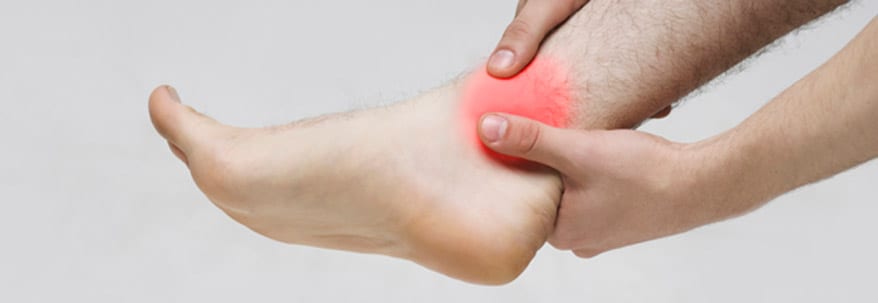
Podiatric trauma may occur during sports, play or falls, but may also develop as a result of everyday wear and tear, overuse or injury.
Types of Trauma
Podiatric trauma may involve a sudden (acute) injury or stem from overuse injuries.
Acute injuries may include:
- Bruises, or contusions, that may extend to the toes
- Puncture wounds may be caused by sharp objects, and possibly lead to infection
- Ligament injuries
- Tendon injuries, such as ruptured tendons (Achilles tendon)
- Joint injuries, or sprains
- Pulled muscles, or sprains
- Broken bones, or fractures (such as broken toe)
- Dislocation
- Crushing injury, which may lead to compartment syndrome


Overuse injuries may include:
- Retrocalcaneal bursitis, which is inflammation of the bursa, may cause swelling and tenderness of the back of the heel and ankle. Pain worsens while wearing shoes and during activity.
- Achilles tendonitis is the breakdown of soft tissues in and around the Achilles tendon.
- Stress fracture is a hairline crack in the bone.
- Plantar fasciitis is an inflammation of the plantar fascia, which is a broad, flat ligament on the bottom of the foot.
- Metatarsalgia is pain in the front, or ball, of the foot.
Risk Factors for Podiatric Trauma
The following factors increase the likelihood of podiatric trauma:
- Participating in sports that involve jumping, such as basketball
- Participating in sports that involve making quick changes in direction, such as soccer or football
- Being a dancer or gymnast
- Being an older adult, due to loss of muscle mass and bone strength and problems with vision and balance
Symptoms of Podiatric Trauma
A sprain or fracture of the foot or ankle may cause the following symptoms:
- Swelling
- Bruising
- Worsening pain when putting weight on the injured foot
- Restricted range of motion or instability
Patients experiencing symptoms of a foot, ankle or toe injury should schedule an appointment with their primary physician for diagnosis and treatment.
How Podiatric Trauma is Diagnosed
During an initial visit, the physician will examine the patient’s foot, ankle or toe and ask questions about the history of the injury. The physician may also order imaging tests to obtain a better picture of the injury. Types of imaging tests include:
- Bone scan. The technician will inject radioactive material into a vein. The radioactive material will travel to the parts of bones that have been damaged and will show up as bright spots on an imaging scan.
- X-ray. The technician will take X-rays from several different angles to obtain a better picture of the bone.
- Magnetic resonance imaging (MRI). MRI scans will visualize ligaments and bones and identify fractures not captured by an X-ray.
- Computerized tomography (CT). CT scans will offer additional detailed information about the bone and the surrounding soft tissue.
How Podiatric Trauma is Treated
Treatment for toe, foot, or ankle injuries may include:
- Wearing a brace, splint or cast
- Wearing an orthotic device
- Physical therapy
- Medication
- Surgery
Treatment for podiatric trauma will depend on when the injury occurred; the patient’s age, overall health condition and activities; and the location, type and severity of the injury.


